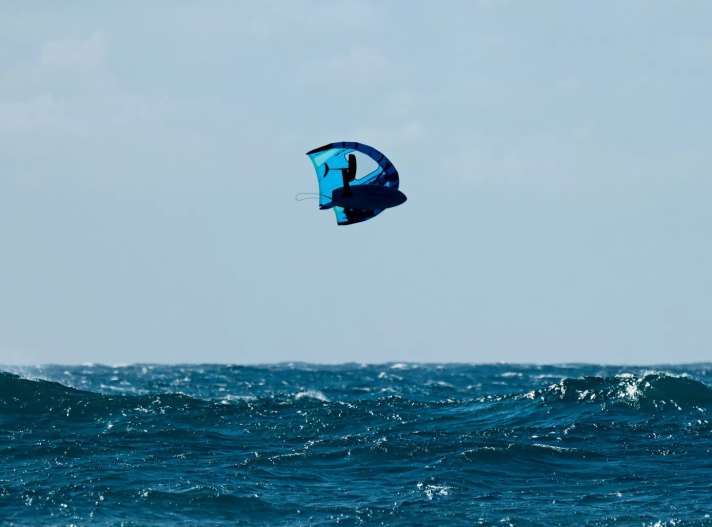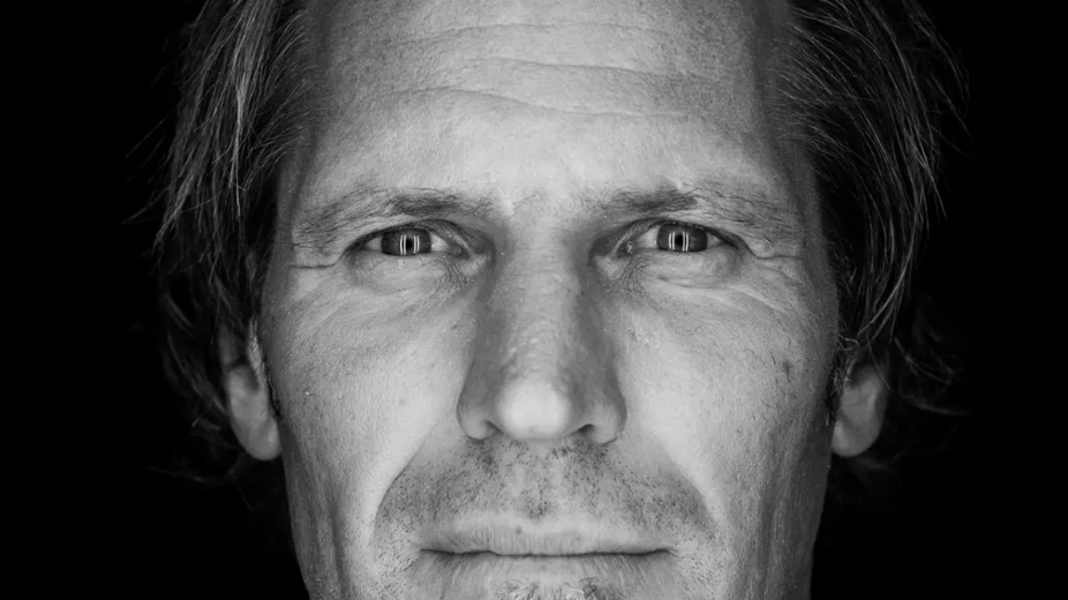
Michi, when did you see stand-up paddling for the first time?
Back in 2004, Dave Kalama and Laird Hamilton paddled down the coast on tandem surfboards. Sometimes their friend Loch Eggers joined them. One day - I was at Camp One Beach testing windsurf boards - Loch landed on the beach after one of these downwinders and said to me: "Why don't you try my SUP?"
And how was it?
It was pretty wobbly, because Loch used a surfing longboard; SUPs didn't exist yet. Nevertheless, I thought it was so funny that I soon suggested to our shaper Harold Iggy that we build our own SUP.
What did that look like?
Large. 12 feet long, but only 25 inches wide. So it was also a pretty wobbly affair. When we put friends on it, they fell in the water. We then made our first production board wider, it came onto the market in 2007 and it was a good all-rounder. Everyone had fun on it.
What is your favourite place to go paddling on Maui?
In Kauai or on the outer reefs. Where nobody is. This has become easy because most people no longer go SUPing. The SUP scene on Maui is shrinking.
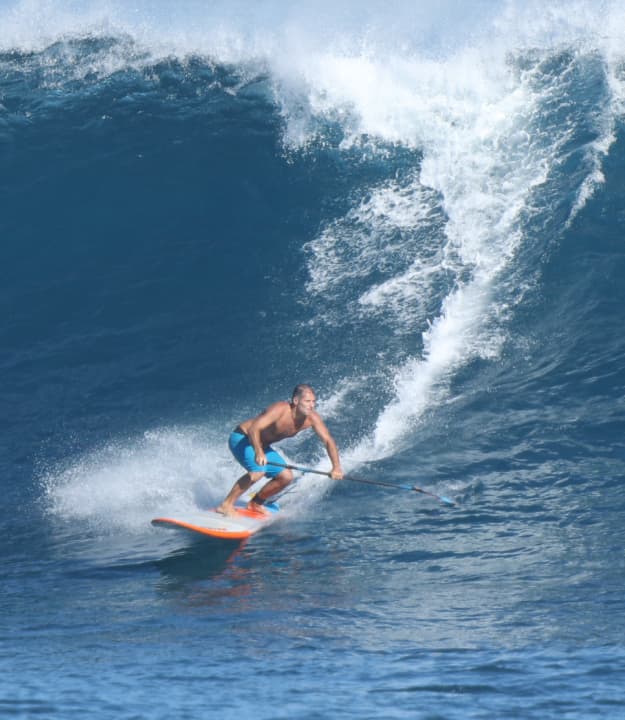
How do you explain that?
On Maui, people want to surf. Other disciplines have become more exciting. Prone foiling and wing foiling, for example. Or many have returned to classic surfing. Only on the south side in flat water is SUP still a big thing.
Does this have something to do with the fact that the image of the SUP has fizzled out when everyone has a Lidl board in the cellar?
I don't believe that at all. It's more to do with the fact that surfers and SUPers don't go well together. It's so easy to catch waves on a SUP. That's why suddenly people were paddling around in the surf who didn't really belong there and didn't make any friends among surfers with their behaviour. But the main reason is that many people are now fascinated by foiling. It's new, it's hip and foiling has the same fascination as SUP.
Which would be?
You can get away from other people, surf at remote spots and ride waves that aren't suitable for classic surfing.
Swell waves, for example. You now do that with the foil SUP. Is this the new evolutionary stage of SUP?
Downwinding with a foil is a crazy experience. You ride a wave for 30 minutes - endless surfing! Yes, I see foil SUP as the evolution of SUP - it's going to be an exciting future.
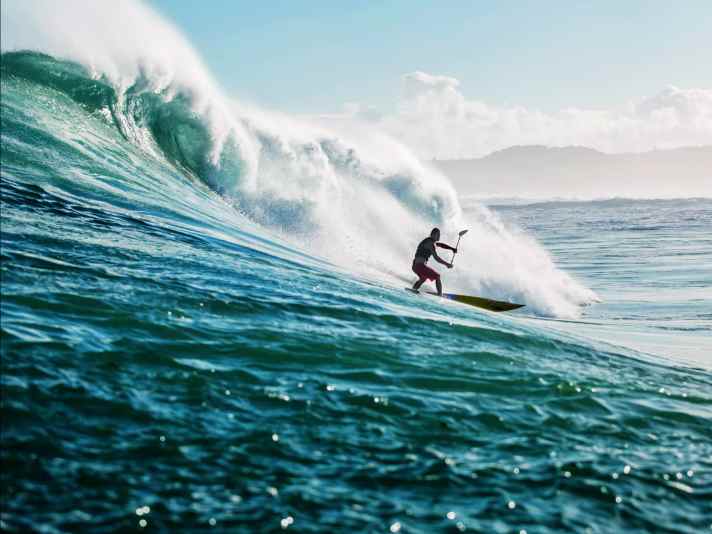
How exactly does it work?
I use my normal foil board, which I also use for wingfoiling. It has a volume of 95 litres and a high-aspect foil. I paddle out with it in Maliko Bay when it's windy. That's when the initial spark comes: With a good paddling technique, I pump myself onto the foil. Once I'm on top, I can ride the windswell all the way down the coast.
How long can you stay on top?
If I don't make a mistake, the current never lets up and I can keep going for the whole 15 kilometres.
And how often do you have to paddle?
Whenever I need to connect the individual windswells together. I help with the paddle or pump the foil with my legs. I usually pump more than I paddle.
Can a normal person learn this?
He can. But he has to really get stuck in. My first runs were difficult because I only got on the foil twice and then only for 20 metres. But that was enough to get me excited. Over time, the foil runs got longer and longer. It took me 10 runs before I was able to surf long stretches on the foil.
Is that a great feeling?
Super - a crazy feeling! You fly over the water down the coast. I really enjoy it.
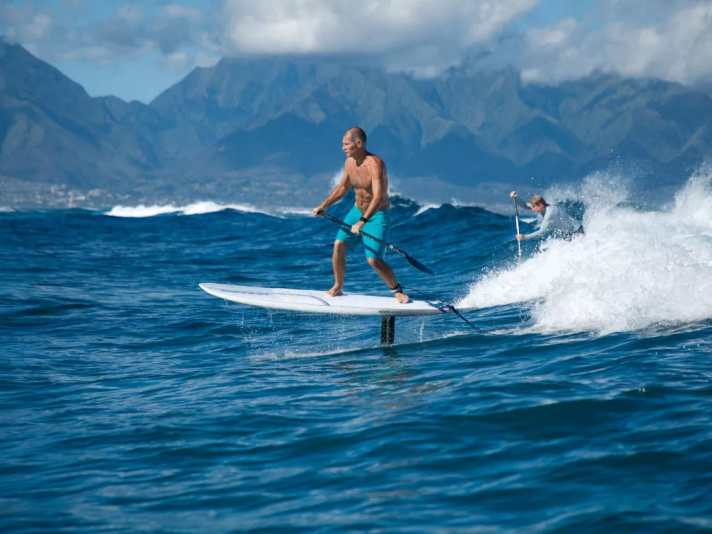
So far out at sea - that scares many people. What could go wrong?
If you don't have a heart attack when you paddle out (laughs), then nothing really. Because you have a board with enough volume and a paddle. So you can paddle ashore at any time.
But when Connor Baxter did that, a tiger shark bit into his foil.
Crazy, I know. The shark probably thought the foil was a fish. But the shark left immediately when it realised that the foil didn't taste good. No, I'm not afraid of sharks - I'm on the board.
That sounds like Waterman. Who can call themselves Waterman?
It's a fashionable term that everyone interprets differently. For me, a waterman is someone who has respect for the sea, swims, surfs, dives, windsurfs, paddles ... whatever and can't be categorised.
After that, even I would be a Waterman.
Of course. Waterman is not a title of nobility like king, count or baron.
So it's not just Kai Lenny or Laird Hamilton who are Watermen?
Not according to my definition.
Watermen ride big waves like Jaws. Does Jaws with the SUP appeal to you?
No, because Jaws is far too crowded for me. When Jaws breaks, everyone flocks there. It's like a funfair. I'd rather go somewhere else.
And where are you going?
To the outer reefs. On Maui or Oahu. I've already surfed similarly high waves there with the SUP.
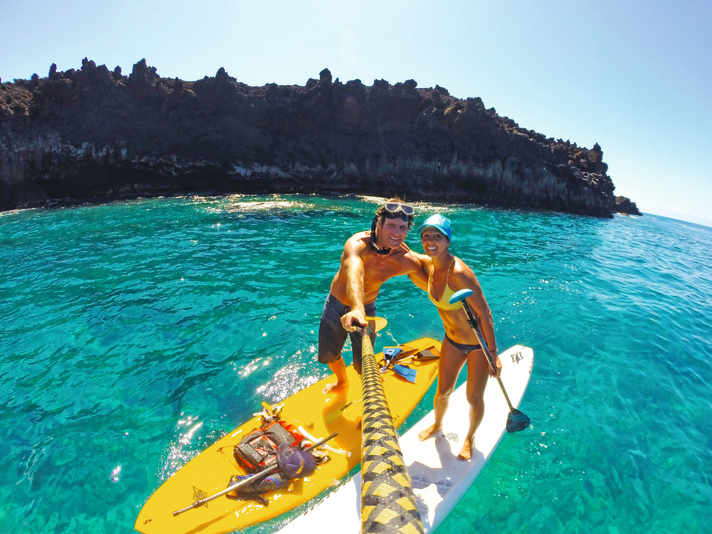
You are also a freediver - does that help in big waves?
This helps, prevents panic and boosts self-confidence. You have to prepare yourself mentally and physically for big waves. I practise this and can therefore hold my breath for a long time even under stress.
How low can you go in one breath?
30 metres. My deepest was 45 metres. That's where freediving really starts. With the right breathing technique, you learn it pretty quickly.
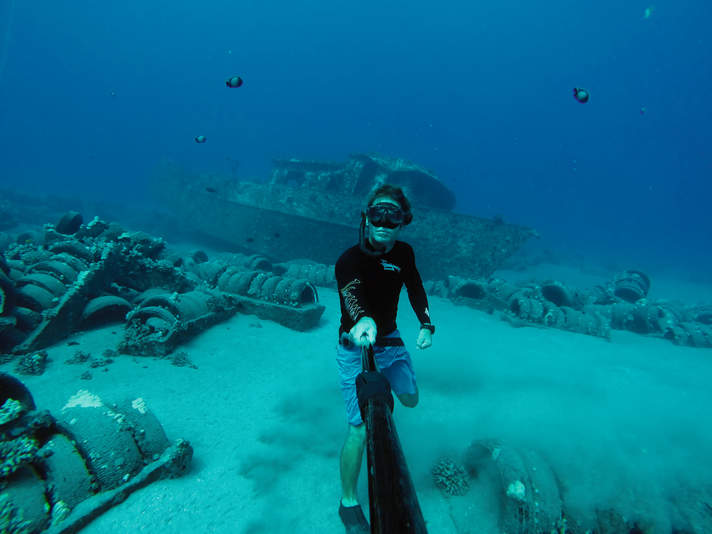
Watermen stuff! Are there also waterwomen?
Of course. The first one that comes to mind is Andrea Moller. She is one of the top women in Jaws. She foils, windsurfs, paddles - she has won the "Molokai to Oahu" race several times. But there is a whole waterwomen scene on Maui.
Kai Lenny is the epitome of a Waterman. He was your team rider. Why can he do everything?
Kai grew up in the sea and has the right mentality: he always wants to improve. That's what drives him. His advantage: he has learnt many water sports and combines them. He learnt his sense of speed from windsurfing, for example, and transfers it to surfing. This helps him in big waves.
Is Kai Lenny a greater athlete than Robby Naish?
What Robby has achieved in his life is hard to beat. It's a different time now.
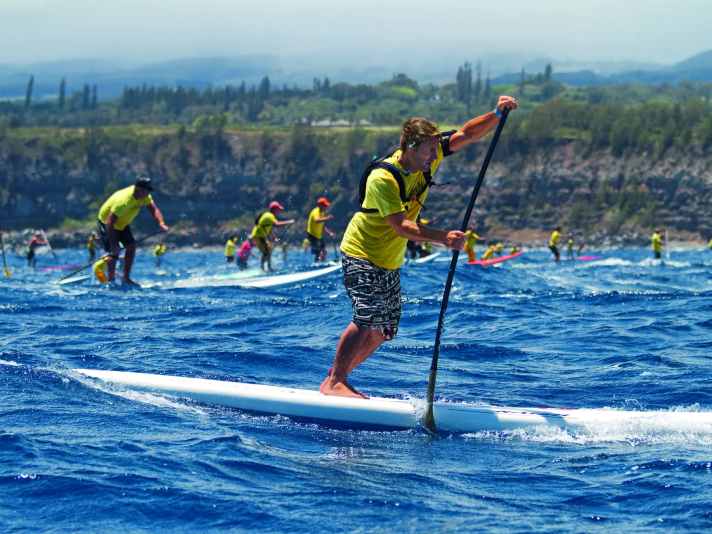
Which SUP athlete impresses you?
Kai has set many standards in SUP racing and SUP wave riding. In racing: Connor Baxter and in Europe Casper Steinfath. When it comes to adventure and endurance, Bart de Zwart impresses me.
Are you also tempted to paddle down the Yukon like Bart de Zwart?
No. That would be far too strenuous for me. I've already taken part in the "Molokai to Oahu" race 12 times, but the distance is more of a sprint for Bart (laughs).
The "Molokai to Oahu" race is considered an endurance test. What is so challenging about it?
You cross the Kaiwi Channel, which translates as "Bone Channel", because the Pacific Ocean here is rock hard. The channel is said to be one of the wildest straits in the world. 42 kilometres with currents and huge swells. You need a good strategy and the right mindset.
And the "Battle of the Paddle" race?
You race around buoys and through the surf zone. Both races are tough, but I like open-ocean racing because it's more of a battle with yourself than against others and you're far out at sea.
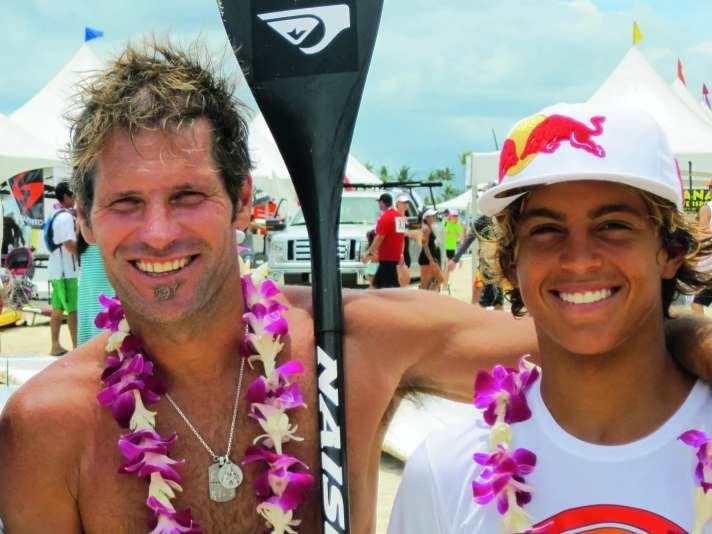
It's amazing how SUP has developed, even though your boss Robby Naish was sceptical at first.
Only until he tried it out for himself. People are still like that today: sceptical at first, then enthusiastic. As a SUP ambassador, Robby has helped to make the sport so popular, especially in Europe.
Did you realise that SUP would become so big?
No. I didn't even think about it. I enjoyed it and I was sure that many other people would feel the same way. It's not in my DNA to say: "We have to do this now because it's going to be big business."
Which SUP discipline is the strongest?
The boards that sell best are the ones that most people have fun with. Above all, of course, the inflatables.
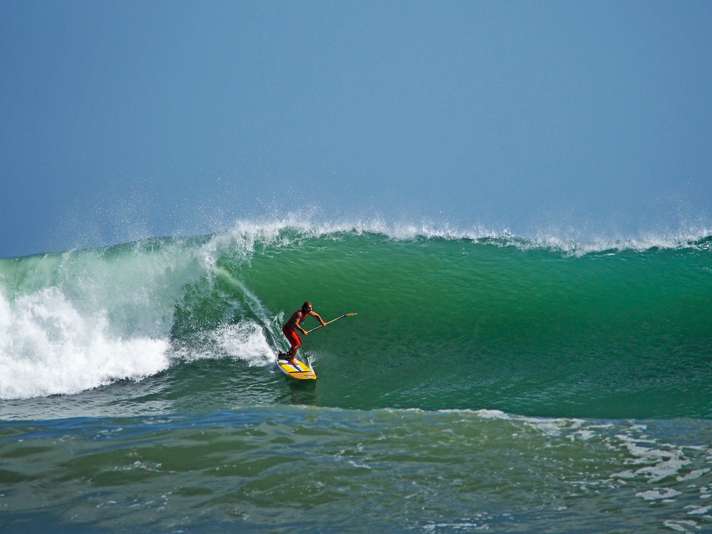
Critics claim that the same mistakes have been made in SUP as in windsurfing: ever more extreme boards. Is that true?
Yes, that's how it was. But that's human nature. Instead of improving themselves, they prefer to reach for a more radical board. The limit is the athlete himself. I say: it's better to have more board volume and enough width and be able to control it than to have a narrow mini board and stagger around on it. You should be able to stand comfortably on it to paddle out to the waves in peace. I often see people on boards that are too small. Half the time they fall into the water and don't catch any waves. No wonder they get frustrated.
Is anything else happening in the board design?
It depends on the discipline. But a good board is a good board, even if it's a few years old.
I'm thinking of your inflatable Naish One.
That's right. It's the same design as it was at the very beginning, more than 12 years ago. It drives well and can be used universally. There's no reason to change anything.
Inflatables have a tendency to twist. Is this a manufacturing problem?
Inflatables have the advantage that they fit in a rucksack, but the disadvantage that they are an inflatable. An inflatable board is not as direct as a composite board and the shape is not guaranteed as with a composite board. You need to be aware of this. Twist should be noticed during quality control. But sometimes twist only appears later. It is usually a cosmetic problem.
In the past, it was not possible to specify how long inflatables would last. Is that possible now?
That depends on you. If you leave it folded up in the garage for two years and then pump it up again, it may fall apart.
What can I do to increase the shelf life?
If you are not going to use it for a long time, it is best to inflate it slightly. Then there will be no creases.
Now Aldi and Lidl also offer SUPs. What makes them different from your boards?
These suppliers do not come from the water sports scene. They benefit from the product development that we and the other brands do, save on distribution and usually choose designs that are cheaper.
The first paddles had a blade the size of a pizza tray. Why were they so wrong?
At first we orientated ourselves on canoe paddles. The blades are very large. In the beginning, we also used very long paddles. That dictated the frequency. The longer the paddle, the slower your paddle stroke. But with the evolution of the sport, the paddles became shorter and shorter, the frequency higher and therefore the paddle blades smaller. Casper Steinfath, for example, has shortened his paddles further and further in order to be able to paddle so fast that he can glide his board in sprints. This would not be possible with a long paddle because you need too long to swing it forwards again. Short paddles are also more ergonomic.
How come?
If your paddle is too long, you overstretch your shoulder. You raise your arm above the horizontal, which can damage your shoulder in the long term.
Foil SUP seems to be the next level. What's going on?
The high-aspect foils are getting better. This allows you to glide earlier and be more stable on the foil.
Windsurfing instructor on Lake Garda, World Cup windsurfer, board developer in Hawaii - Michi Schweiger loves the water and has centred his life around it.
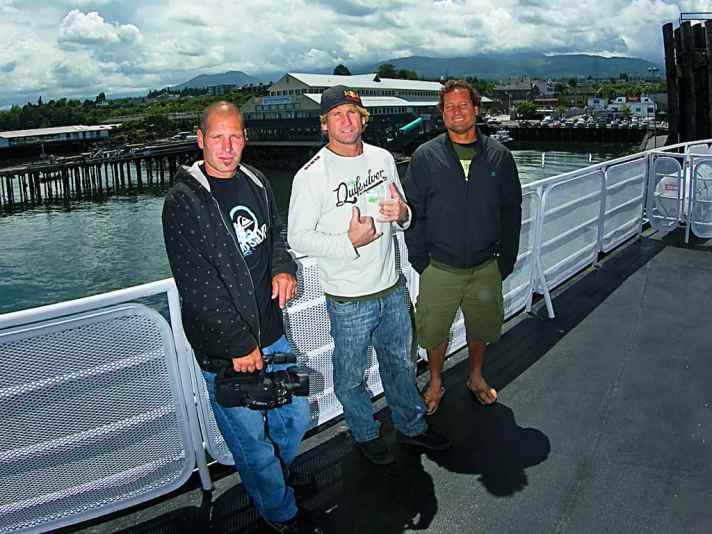
Your CV is impressive - from windsurfer on Lake Garda to waterman in Hawaii and right-hand man to Robby Naish. That sounds a bit like: from rags to riches.
Ha ha, I think my whole life has been characterised by what I wanted to do. Namely: to be in the water. And to learn all the sports that are now close to my heart. That was the driving force and that's why everything turned out the way it did.
If I had told you in 1995 on Lake Garda that you would be surfing Jaws and foiling down the coast with Robby Naish, you would probably have freaked out.
Maybe, maybe not. Back then, I didn't plan anything, I just did what I enjoyed. The rest is stubbornness, dedication and the drive to do what my heart beats for. Most people in our scene feel that way. They took paths that you can't learn at school.
Are you grateful for that?
And how! When I sit down with my friend Mike Eskimo after a good day on the water, we often say: "It's great that we ended up here. We live in a beautiful place and still know how to experience life to the full."
You are both no longer the youngest. Is SUP a good sport for older people?
Yes, it is. As long as you don't use a paddle that is too long.
